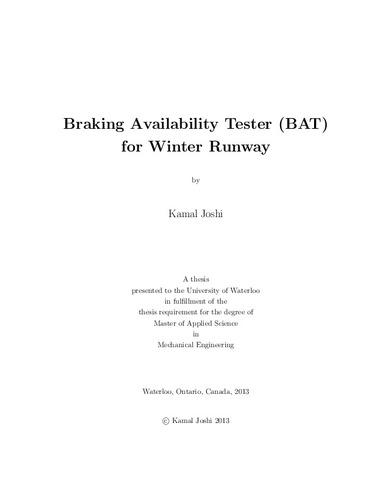| dc.contributor.author | Joshi, Kamal | |
| dc.date.accessioned | 2013-08-29 14:31:53 (GMT) | |
| dc.date.available | 2013-08-29 14:31:53 (GMT) | |
| dc.date.issued | 2013-08-29T14:31:53Z | |
| dc.date.submitted | 2013 | |
| dc.identifier.uri | http://hdl.handle.net/10012/7762 | |
| dc.description.abstract | This thesis is concerned with the development of a new measurement device for the realistic assessment of braking capability of landing airplanes for winter runways. Landing represents one of the most safety-critical phases of aircraft operation. Aircraft runway excursion incidents occur due to the unpredictability of the runway pavement condition. This is especially true during winter time when the runway is often covered by deformable contaminants. Several accidents are discussed that list the deteriorated condition of the runway pavement and the inability to accurately report this condition as the main causes for the excursions. The accuracy of the approaches currently adopted by the airport authorities around the world to monitor the condition of the runway pavement are evaluated.
The conventional and current practice of runway condition monitoring is focused on identifying the maximum tire-pavement frictional drag mu value and often neglects the characteristics of actual aircraft brake control system as well as the comprehensive effects coming from various factors such as deformable contaminants on the winter runway. The braking availability tester discussed here is designed to take a different approach for the realistic assessment of braking availability of landing aircrafts. The main idea of this device is to mimic the braking operation of actual aircrafts as closely as possible by incorporating the same brake mechanism and the brake control system used in existing aircrafts. The architecture of the device from the ground-up including the suite of sensors, the structure of the wheel, important actuators, and the real-time brake control system are discussed in detail. More importantly, the operational principles of the braking availability tester (BAT) are outlined which help one understand how the system works together.
A new method to quantify the braking availability on the runway using the BAT is explained. The testing and data collection strategy for implementing this technique is also outlined. Additionally, the results from preliminary tests are presented to verify the functionality of the BAT. The results are used to verify that the BAT operates with the brake control system of an aircraft. Finally, experimental data sets from dry and contaminated pavement testing are presented to show the effect of different weather conditions on the operation of the BAT. | en |
| dc.language.iso | en | en |
| dc.publisher | University of Waterloo | en |
| dc.subject | Braking Availability Tester (BAT) | en |
| dc.subject | Winter | en |
| dc.subject | Friction | en |
| dc.subject | Contaminated | en |
| dc.subject | Runway | en |
| dc.title | Braking Availability Tester (BAT) for Winter Runway | en |
| dc.type | Master Thesis | en |
| dc.pending | false | en |
| dc.subject.program | Mechanical Engineering | en |
| uws-etd.degree.department | Mechanical and Mechatronics Engineering | en |
| uws-etd.degree | Master of Applied Science | en |
| uws.typeOfResource | Text | en |
| uws.peerReviewStatus | Unreviewed | en |
| uws.scholarLevel | Graduate | en |

